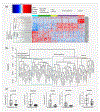Long intergenic noncoding RNA profiles of pheochromocytoma and paraganglioma: A novel prognostic biomarker
- PMID: 31469413
- PMCID: PMC7454041
- DOI: 10.1002/ijc.32654
Long intergenic noncoding RNA profiles of pheochromocytoma and paraganglioma: A novel prognostic biomarker
Abstract
Many long intergenic noncoding RNAs (lincRNAs) serve as cancer biomarkers for diagnosis or prognostication. To understand the role of lincRNAs in the rare neuroendocrine tumors pheochromocytoma and paraganglioma (PCPG), we performed first time in-depth characterization of lincRNA expression profiles and correlated findings to clinical outcomes of the disease. RNA-Seq data from patients with PCPGs and 17 other tumor types from The Cancer Genome Atlas and other published sources were obtained. Differential expression analysis and a machine-learning model were used to identify transcripts specific to PCPGs, as well as established PCPG molecular subtypes. Similarly, lincRNAs specific to aggressive PCPGs were identified, and univariate and multivariate analysis was performed for metastasis-free survival. The results were validated in independent samples using RT-PCR. From a pan-cancer context, PCPGs had a specific and unique lincRNA profile. Among PCPGs, five different molecular subtypes were identified corresponding to the established molecular classification. Upregulation of 13 lincRNAs was found to be associated with aggressive/metastatic PCPGs. RT-PCR validation confirmed the overexpression of four lincRNAs in metastatic compared to non-metastatic PCPGs. Kaplan-Meier analysis identified five lincRNAs as prognostic markers for metastasis-free survival of patients in three subtypes of PCPGs. Stratification of PCPG patients with a risk-score formulated using multivariate analysis of lincRNA expression profiles, presence of key driver mutations, tumor location, and hormone secretion profiles showed significant differences in metastasis-free survival. PCPGs thus exhibit a specific lincRNA expression profile that also corresponds to the established molecular subgroups and can be potential marker for the aggressive/metastatic PCPGs.
Keywords: biomarkers; lincRNA; molecular subtypes; paraganglioma; pheochromocytoma.
© 2019 UICC.
Figures




Similar articles
-
A long noncoding RNA-microRNA expression signature predicts metastatic signature in pheochromocytomas and paragangliomas.Endocrine. 2022 Jan;75(1):244-253. doi: 10.1007/s12020-021-02857-0. Epub 2021 Sep 18. Endocrine. 2022. PMID: 34536193 Free PMC article.
-
Immune signature of pheochromocytoma and paraganglioma in context of neuroendocrine neoplasms associated with prognosis.Endocrine. 2023 Jan;79(1):171-179. doi: 10.1007/s12020-022-03218-1. Epub 2022 Nov 12. Endocrine. 2023. PMID: 36370152 Free PMC article.
-
Clinicopathological characteristics of pheochromocytoma/paraganglioma and screening of prognostic markers.J Surg Oncol. 2023 Sep;128(4):510-518. doi: 10.1002/jso.27358. Epub 2023 Jun 5. J Surg Oncol. 2023. PMID: 37272486
-
Genotype-phenotype correlations in pheochromocytoma and paraganglioma: a systematic review and individual patient meta-analysis.Endocr Relat Cancer. 2019 May;26(5):539-550. doi: 10.1530/ERC-19-0024. Endocr Relat Cancer. 2019. PMID: 30893643 Free PMC article.
-
New Perspectives on Pheochromocytoma and Paraganglioma: Toward a Molecular Classification.Endocr Rev. 2017 Dec 1;38(6):489-515. doi: 10.1210/er.2017-00062. Endocr Rev. 2017. PMID: 28938417 Free PMC article. Review.
Cited by
-
A Critical Appraisal of Contemporary and Novel Biomarkers in Pheochromocytomas and Adrenocortical Tumors.Biology (Basel). 2021 Jun 25;10(7):580. doi: 10.3390/biology10070580. Biology (Basel). 2021. PMID: 34201922 Free PMC article. Review.
-
A long noncoding RNA-microRNA expression signature predicts metastatic signature in pheochromocytomas and paragangliomas.Endocrine. 2022 Jan;75(1):244-253. doi: 10.1007/s12020-021-02857-0. Epub 2021 Sep 18. Endocrine. 2022. PMID: 34536193 Free PMC article.
-
Pheochromocytoma: a changing perspective and current concepts.Ther Adv Endocrinol Metab. 2023 Oct 29;14:20420188231207544. doi: 10.1177/20420188231207544. eCollection 2023. Ther Adv Endocrinol Metab. 2023. PMID: 37916027 Free PMC article. Review.
-
The Role of the Metabolome and Non-Coding RNA on Pheochromocytomas and Paragangliomas: An Update.Metabolites. 2022 Feb 1;12(2):131. doi: 10.3390/metabo12020131. Metabolites. 2022. PMID: 35208206 Free PMC article.
-
Comprehensive Analysis of Aberrantly Expressed Competitive Endogenous RNA Network and Identification of Prognostic Biomarkers in Pheochromocytoma and Paraganglioma.Onco Targets Ther. 2020 Nov 6;13:11377-11395. doi: 10.2147/OTT.S271417. eCollection 2020. Onco Targets Ther. 2020. PMID: 33192072 Free PMC article.
References
-
- Gatta G, Capocaccia R, Botta L, et al. Burden and centralised treatment in Europe of rare tumours: results of RARECAREnet-a population-based study. Lancet Oncol 2017;18:1022–39. - PubMed
-
- Dahia PL. Pheochromocytoma and paraganglioma pathogenesis: learning from genetic heterogeneity. Nat Rev Cancer 2014;14:108–19. - PubMed
Publication types
MeSH terms
Substances
Grants and funding
LinkOut - more resources
Full Text Sources
Medical

